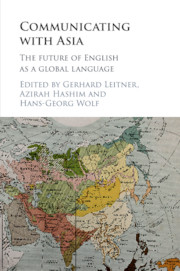Book contents
- Communicating with Asia
- Communicating with Asia
- Copyright page
- Contents
- Figures
- Tables
- Contributors
- Book part
- Communicating with Asia: introduction
- Part I English in selected regional and national habitats with a glance at the role of outward-bound communication needs
- Part II Major other languages in Asia, their international status and impact on education
- 10 Multilingualism, Hindi–Urdu and Indian English: intranational and international diaspora
- 11 Bahasa Indonesia and Bahasa Melayu: convergence and divergence of the official languages in contemporary Southeast Asia
- 12 Putonghua and Cantonese in the Chinese territories
- 13 The Chinese language in the Asian diaspora: a Malaysian experience
- 14 Russian in Far East Asia: linguistic policies on the periphery of empire
- 15 Russian and Turkic languages in Central Asia
- Part III Wider perspectives
- Bibliography
- Index
14 - Russian in Far East Asia: linguistic policies on the periphery of empire
from Part II - Major other languages in Asia, their international status and impact on education
Published online by Cambridge University Press: 05 January 2016
- Communicating with Asia
- Communicating with Asia
- Copyright page
- Contents
- Figures
- Tables
- Contributors
- Book part
- Communicating with Asia: introduction
- Part I English in selected regional and national habitats with a glance at the role of outward-bound communication needs
- Part II Major other languages in Asia, their international status and impact on education
- 10 Multilingualism, Hindi–Urdu and Indian English: intranational and international diaspora
- 11 Bahasa Indonesia and Bahasa Melayu: convergence and divergence of the official languages in contemporary Southeast Asia
- 12 Putonghua and Cantonese in the Chinese territories
- 13 The Chinese language in the Asian diaspora: a Malaysian experience
- 14 Russian in Far East Asia: linguistic policies on the periphery of empire
- 15 Russian and Turkic languages in Central Asia
- Part III Wider perspectives
- Bibliography
- Index
Summary
The aim of this chapter is to provide a historically and culturally grounded overview of the Russian language as a lingua franca in Far East Asia. Among the factors that contributed to the spread of Russian in the Far East are the colonization of Siberia and the Far East during the Tsarist Empire, the constitution of the USSR as a multinational state as well as Soviet language policy and the revivalist neo-communist politics of Vladimir Putin. On the other hand, the use of Russian as a means of international communication in East Asia (especially in China) is a consequence of globalization and work-related migration. However, due to the long history of conflicts between Russia and its neighbours and to the current prestige of global English, English remains the preferred lingua franca in international trade in Far East Asia.
- Type
- Chapter
- Information
- Communicating with AsiaThe Future of English as a Global Language, pp. 216 - 230Publisher: Cambridge University PressPrint publication year: 2016

